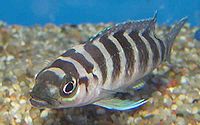
Neolamprologus
Encyclopedia
Neolamprologus is a genus
of cichlid
fishes endemic
to eastern Africa with all but one species occurring in Lake Tanganyika
. It is the largest genus of cichlids in Lake Tanganyika and also the largest genus in the tribe Lamprologini
, which includes Altolamprologus
, Chalinochromis
, Julidochromis
, Lamprologus
, Lepidiolamprologus
, Telmatochromis
and Variabilichromis
. The latter is a monotypic
genus doubtfully distinct from Neolamprologus.
It is already known for some time that according to mtDNA sequence
analysis, this genus is very probably polyphyletic. It is likely that it will be revised eventually; if Variabilichromis is split off, at least some of the more ancient lineages currently polaced in Neolamprologus are probably worthy of separation also. However, the morphological
similarity and numerous undescribed species do not make analyses easier, and as with many cichlids, recent speciation
and abundant hybridization seriously confound molecular studies to the point where single-gene studies or those using only mtDNA or nDNA are essentially worthless for resolving Lamprologini phylogeny.
While lineages are clearly different in their morphology, habits and ecology, gene flow
between genera and species is common enough due to extremely low postzygotic isolation
. Males of Neolamprologus apparently have always readily and successfully mated with females of other Lamprologini they found ready to spawn: mtDNA lineages similar to other Lamprologini genera are widely encountered in species placed in Neolamprologus. And not only do such hybrids seem to be fertile at least to a limited extent in many cases, new species often appear to originate from such interbreeding.
is sometimes placed in Altolamprologus
, and this seems well warranted. Some other species are occasionally moved to Lepidiolamprologus
; this placement may also be correct but requires verification.

Genus
In biology, a genus is a low-level taxonomic rank used in the biological classification of living and fossil organisms, which is an example of definition by genus and differentia...
of cichlid
Cichlid
Cichlids are fishes from the family Cichlidae in the order Perciformes. Cichlids are members of a group known as the Labroidei along with the wrasses , damselfish , and surfperches . This family is both large and diverse. At least 1,300 species have been scientifically described, making it one of...
fishes endemic
Endemic (ecology)
Endemism is the ecological state of being unique to a defined geographic location, such as an island, nation or other defined zone, or habitat type; organisms that are indigenous to a place are not endemic to it if they are also found elsewhere. For example, all species of lemur are endemic to the...
to eastern Africa with all but one species occurring in Lake Tanganyika
Lake Tanganyika
Lake Tanganyika is an African Great Lake. It is estimated to be the second largest freshwater lake in the world by volume, and the second deepest, after Lake Baikal in Siberia; it is also the world's longest freshwater lake...
. It is the largest genus of cichlids in Lake Tanganyika and also the largest genus in the tribe Lamprologini
Lamprologini
Lamprologini is a tribe of African cichlid fishes. It contains seven genera and nearly 100 species. Over half of the species in this tribe are in the large genus Neolamprologus. Most genera in the tribe are endemic to Lake Tanganyika, but one species of Neolamprologus Lamprologini is a tribe of...
, which includes Altolamprologus
Altolamprologus
Altolamprologus is a small genus of pseudocrenilabrine cichlids endemic to Lake Tanganyika in eastern Africa. They inhabit areas of the lake with large amounts of rock, most frequently in water two to ten metres in depth. Two formally described species comprise this genus, with perhaps one dwarf A....
, Chalinochromis
Chalinochromis
Chalinochromis is a small and disputed cichlid genus from the subfamily Pseudocrenilabrinae; it contains just two species. These ray-finned fishes are endemic to Lake Tanganyika in Eastern Africa's Great Rift Valley. The scientific name refers to the bridle-like markings across the heads of members...
, Julidochromis
Julidochromis
Julidochromis is a genus of cichlids in the subfamily Pseudocrenilabrinae. They are commonly called julies and are endemic to Lake Tanganyika in eastern Africa. This genus includes at least 5 species, each with a number of subspecies and local variants of uncertain taxonomic status...
, Lamprologus
Lamprologus
Lamprologus is a genus of fishes from the cichlid family. They are native to Lake Tanganyika and the Congo River Basin in Africa. The type species for this genus is Lamprologus congoensis, a species from the Congo River. The genus is under some revision and may eventually be restricted to these...
, Lepidiolamprologus
Lepidiolamprologus
Lepidiolamprologus is a small genus of cichlids endemic to Lake Tanganyika in eastern Africa. It is closely related to Altolamprologus....
, Telmatochromis
Telmatochromis
Telmatochromis is a small cichlid genus of the subfamily Pseudocrenilabrinae. These ray-finned fishes are endemic to Lake Tanganyika in East Africa.-Systematics:7 species are included here...
and Variabilichromis
Variabilichromis
Variabilichromis is a monotypic genus of fish in the family Cichlidae which occurs in Lake Tanganyika, of the rift lakes in Eastern Africa. The single species, Variabilichromis moorii is a small ovate bodied fish named for an early collector of fish from the lake, J. Moore. Juveniles are lighter in...
. The latter is a monotypic
Monotypic
In biology, a monotypic taxon is a taxonomic group with only one biological type. The term's usage differs slightly between botany and zoology. The term monotypic has a separate use in conservation biology, monotypic habitat, regarding species habitat conversion eliminating biodiversity and...
genus doubtfully distinct from Neolamprologus.
It is already known for some time that according to mtDNA sequence
DNA sequence
The sequence or primary structure of a nucleic acid is the composition of atoms that make up the nucleic acid and the chemical bonds that bond those atoms. Because nucleic acids, such as DNA and RNA, are unbranched polymers, this specification is equivalent to specifying the sequence of...
analysis, this genus is very probably polyphyletic. It is likely that it will be revised eventually; if Variabilichromis is split off, at least some of the more ancient lineages currently polaced in Neolamprologus are probably worthy of separation also. However, the morphological
Morphology (biology)
In biology, morphology is a branch of bioscience dealing with the study of the form and structure of organisms and their specific structural features....
similarity and numerous undescribed species do not make analyses easier, and as with many cichlids, recent speciation
Speciation
Speciation is the evolutionary process by which new biological species arise. The biologist Orator F. Cook seems to have been the first to coin the term 'speciation' for the splitting of lineages or 'cladogenesis,' as opposed to 'anagenesis' or 'phyletic evolution' occurring within lineages...
and abundant hybridization seriously confound molecular studies to the point where single-gene studies or those using only mtDNA or nDNA are essentially worthless for resolving Lamprologini phylogeny.
While lineages are clearly different in their morphology, habits and ecology, gene flow
Gene flow
In population genetics, gene flow is the transfer of alleles of genes from one population to another.Migration into or out of a population may be responsible for a marked change in allele frequencies...
between genera and species is common enough due to extremely low postzygotic isolation
Isolating mechanisms
Isolating Mechanisms are features of behavior, morphology, or genetics which serve to prevent breeding between species. Reproductive isolation of populations is established. It is particularly important to the biological species concept, as species are defined by reproductive isolation...
. Males of Neolamprologus apparently have always readily and successfully mated with females of other Lamprologini they found ready to spawn: mtDNA lineages similar to other Lamprologini genera are widely encountered in species placed in Neolamprologus. And not only do such hybrids seem to be fertile at least to a limited extent in many cases, new species often appear to originate from such interbreeding.
Species
About 1-2 new species are described every year. Neolamprologus fasciatusNeolamprologus fasciatus
Altolamprologus fasciatus is a cichlid species in the subfamily Pseudocrenilabrinae. It is endemic to Lake Tanganyika, where it is found in the waters of Burundi, the Democratic Republic of the Congo, Tanzania, and Zambia....
is sometimes placed in Altolamprologus
Altolamprologus
Altolamprologus is a small genus of pseudocrenilabrine cichlids endemic to Lake Tanganyika in eastern Africa. They inhabit areas of the lake with large amounts of rock, most frequently in water two to ten metres in depth. Two formally described species comprise this genus, with perhaps one dwarf A....
, and this seems well warranted. Some other species are occasionally moved to Lepidiolamprologus
Lepidiolamprologus
Lepidiolamprologus is a small genus of cichlids endemic to Lake Tanganyika in eastern Africa. It is closely related to Altolamprologus....
; this placement may also be correct but requires verification.


